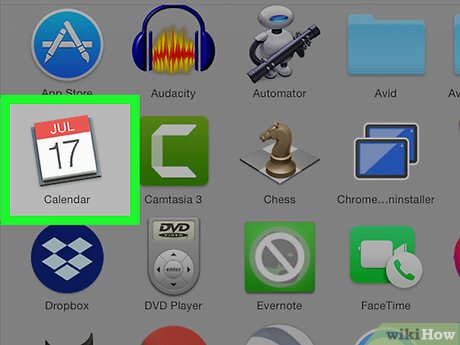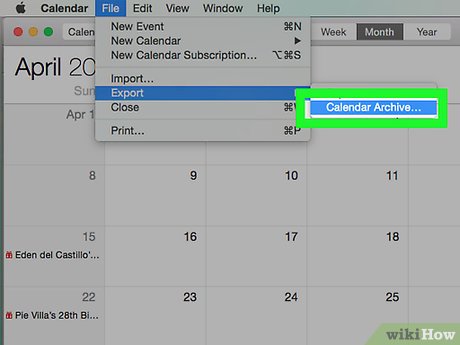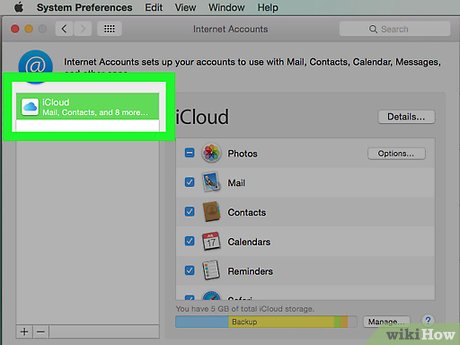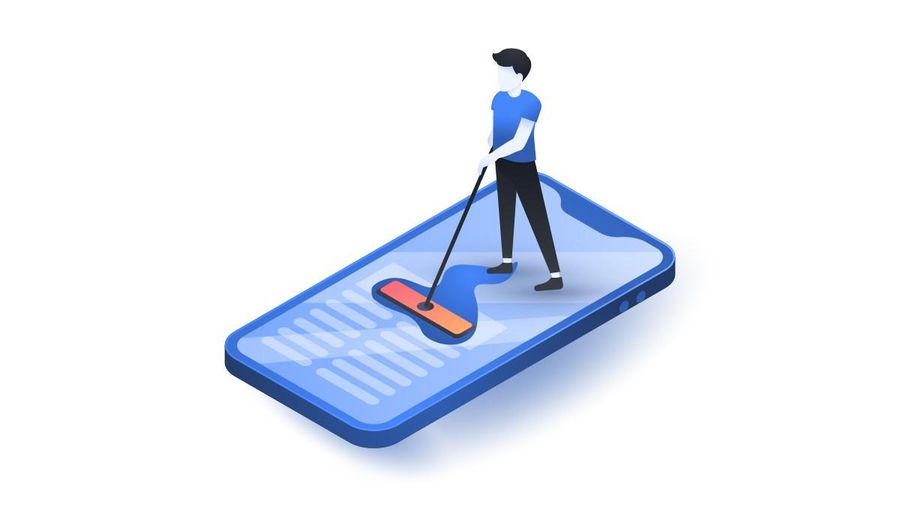How to Clear the iCal Cache
Part 1 of 3:
Preparing to Clear the Cache
-
 Open the Calendar app. Double-click the calendar icon in your Mac's Dock.
Open the Calendar app. Double-click the calendar icon in your Mac's Dock. -
 Back up your calendar's data. If you have multiple calendars synced to different accounts, you'll need to back those up, too. To do so:[1]
Back up your calendar's data. If you have multiple calendars synced to different accounts, you'll need to back those up, too. To do so:[1]- Click File
- Select Export
- Click Calendar Archive
- Select a save location.
-
 Try removing and re-adding the account. You may be able to solve your calendar problem by removing the calendar account from your computer and then adding it back. To do so:
Try removing and re-adding the account. You may be able to solve your calendar problem by removing the calendar account from your computer and then adding it back. To do so:- Click the Apple Menu

- Click System Preferences
- Click Internet Accounts
- Select the calendar's account.
- Click -
- Restart your Mac
- Go back to the Internet Accounts page.
- Select an account provider (e.g., Outlook).
- Enter your account's email address and password.
- Click the Apple Menu
-
 Close and re-open your Calendar. If the problem was fixed, your account simply needed a refresh. If not, continue to the next step.
Close and re-open your Calendar. If the problem was fixed, your account simply needed a refresh. If not, continue to the next step. -
 Double-check your backups before clearing your cache. There is a decent chance that your calendars' contents will be completely deleted if you clear your cache, so make absolutely sure that you have a backup file for each of your calendars. Only proceed after you are certain that you won't lose anything important.
Double-check your backups before clearing your cache. There is a decent chance that your calendars' contents will be completely deleted if you clear your cache, so make absolutely sure that you have a backup file for each of your calendars. Only proceed after you are certain that you won't lose anything important. -
 Close your Calendar app. You are now ready to proceed with clearing your calendar's cache.
Close your Calendar app. You are now ready to proceed with clearing your calendar's cache.
Part 2 of 3:
Clearing the Cache
-
 Open Finder. Click the blue, face-shaped app in the Dock.
Open Finder. Click the blue, face-shaped app in the Dock. -
 Select your Mac's hard drive. It's on the left side of the Finder window, just below the "Devices" heading.
Select your Mac's hard drive. It's on the left side of the Finder window, just below the "Devices" heading. -
 Double-click the Macintosh HD folder. You should see this option near the top of the Finder window.
Double-click the Macintosh HD folder. You should see this option near the top of the Finder window. -
 Double-click the Users folder. This will open the Users folder.
Double-click the Users folder. This will open the Users folder. -
 Double-click the folder with your name on it. This is the personal user folder.
Double-click the folder with your name on it. This is the personal user folder. -
 Press ⌘ Command+⇧ Shift+.. Doing so prompts the hidden folders that are in your personal user folder to display. One such folder is the Library folder.
Press ⌘ Command+⇧ Shift+.. Doing so prompts the hidden folders that are in your personal user folder to display. One such folder is the Library folder. -
 Double-click the Library folder. It's in the middle of the personal user folder.
Double-click the Library folder. It's in the middle of the personal user folder. -
 Double-click the Calendars folder. This folder is in the middle of the Library folder.
Double-click the Calendars folder. This folder is in the middle of the Library folder. -
 Delete any cache files in this folder. There may be several files with "Cache" in their title; select each cache file by holding ⌘ Command and clicking them, then click File and click Move to Trash.
Delete any cache files in this folder. There may be several files with "Cache" in their title; select each cache file by holding ⌘ Command and clicking them, then click File and click Move to Trash.- These cache files are often named things like com.apple.cal.
-
 Click the Trash icon. It's a waste basket-shaped icon in the Dock. A pop-up menu will appear.
Click the Trash icon. It's a waste basket-shaped icon in the Dock. A pop-up menu will appear. -
 Click Empty Trash…. This option is in the pop-up menu.
Click Empty Trash…. This option is in the pop-up menu. -
 Click Empty Trash when prompted. Doing so will most likely trigger an error message that says "The operation can't be completed because the item '[cache file name]' is in use", meaning you'll need to force-quit the Calendar background process and then empty Trash again.
Click Empty Trash when prompted. Doing so will most likely trigger an error message that says "The operation can't be completed because the item '[cache file name]' is in use", meaning you'll need to force-quit the Calendar background process and then empty Trash again.- If you don't see any error messages pop up, your Calendar app's cache has successfully been cleared.
Part 3 of 3:
Force-Quitting Calendar
-
 Click Continue on the error window. You may have to do this for several errors depending on how many files you tried to delete.
Click Continue on the error window. You may have to do this for several errors depending on how many files you tried to delete. -
 Open Spotlight. Click the magnifying glass-shaped icon in the top-right corner of the screen.
Open Spotlight. Click the magnifying glass-shaped icon in the top-right corner of the screen.
-
 Type activity monitor into Spotlight. Doing so searches your Mac for the Activity Monitor app, which is a program that allows you to monitor and halt background processes.
Type activity monitor into Spotlight. Doing so searches your Mac for the Activity Monitor app, which is a program that allows you to monitor and halt background processes. -
 Click Activity Monitor. It's a black box with green lines on it. You should see it near the top of the Spotlight drop-down menu.
Click Activity Monitor. It's a black box with green lines on it. You should see it near the top of the Spotlight drop-down menu. -
 Double-click the "CalendarAgent" entry. This is the Calendar background process. It will open.
Double-click the "CalendarAgent" entry. This is the Calendar background process. It will open. -
 Click Quit. It's in the bottom-right side of the Calendar window.
Click Quit. It's in the bottom-right side of the Calendar window. -
 Click Force Quit when prompted. Doing so will prevent the Calendar background process from running, meaning that you can delete the cache files without interference.
Click Force Quit when prompted. Doing so will prevent the Calendar background process from running, meaning that you can delete the cache files without interference.- You may not see the "CalendarAgent" entry disappear from the Activity Manager when you click Force Quit.
-
 Empty the Trash. Click the Trash Can icon, click Empty Trash..., and click Empty Trash when prompted. You shouldn't experience any errors this time, meaning that your calendar's cached files will be deleted. You have successfully cleared your Mac's Calendar app's cache.
Empty the Trash. Click the Trash Can icon, click Empty Trash..., and click Empty Trash when prompted. You shouldn't experience any errors this time, meaning that your calendar's cached files will be deleted. You have successfully cleared your Mac's Calendar app's cache.
3.8 ★ | 35 Vote
You should read it
May be interested
- How to clear Smart TV cache
 cache is quite useful, but over time it can build up and slow down your smart tv - that's why it's helpful to clear your smart tv cache from time to time.
cache is quite useful, but over time it can build up and slow down your smart tv - that's why it's helpful to clear your smart tv cache from time to time. - How to clear cache and delete different Android application data?
 cache is a temporary storage of certain data files on a device. the purpose of cache is to speed up, make the device more 'smooth' and to reduce the amount of data being processed. when clearing cache data of a certain application, it means deleting temporary files in the cache.
cache is a temporary storage of certain data files on a device. the purpose of cache is to speed up, make the device more 'smooth' and to reduce the amount of data being processed. when clearing cache data of a certain application, it means deleting temporary files in the cache. - How to clear the Cache in Windows 8?
 saving the cache in windows helps to load data faster but will also consume you no less memory. especially when windows 8 operating system runs in parallel with both desktop and modern ui interfaces. therefore, after a period of use, you should delete the cache to free up space for the hard drive.
saving the cache in windows helps to load data faster but will also consume you no less memory. especially when windows 8 operating system runs in parallel with both desktop and modern ui interfaces. therefore, after a period of use, you should delete the cache to free up space for the hard drive. - How to clear cache on iPhone
 iphone's storage is finite, so there comes a point where you won't be able to store anything more. one of the ways to get that space back is to clear the cache.
iphone's storage is finite, so there comes a point where you won't be able to store anything more. one of the ways to get that space back is to clear the cache. - How to clear Telegram cache
 when you use telegram, there will be temporary storage files such as images and videos. therefore, users should check telegram's memory to clear the telegram cache.
when you use telegram, there will be temporary storage files such as images and videos. therefore, users should check telegram's memory to clear the telegram cache. - Clear the Dropbox cache Windows and Linux to free up memory space
 every time you delete any file from your dropbox account, you often think that the file has been permanently deleted. however, you do not know that those files are still hidden in the cache directory on the hard drive for use in emergencies, and for about 3 days these files will be deleted automatically.
every time you delete any file from your dropbox account, you often think that the file has been permanently deleted. however, you do not know that those files are still hidden in the cache directory on the hard drive for use in emergencies, and for about 3 days these files will be deleted automatically. - Instructions for deleting Dropbox's cache on iPhone and iPad
 there are many simple but effective ways to manage memory on ios devices. for example, regularly clearing the cache of applications to free up space to help applications work efficiently. but did you know, you can also delete dropbox's cache on iphone phones?
there are many simple but effective ways to manage memory on ios devices. for example, regularly clearing the cache of applications to free up space to help applications work efficiently. but did you know, you can also delete dropbox's cache on iphone phones? - How to clear the DNS cache buffer in Google Chrome
 clearing the dns cache can help you troubleshoot host connectivity when accessing some websites. in this article, tipsmake.com will guide you to do that.
clearing the dns cache can help you troubleshoot host connectivity when accessing some websites. in this article, tipsmake.com will guide you to do that. - Instructions to clear cache on Twitter are very simple
 when we use the application on twitter for a long time, it will save data, thereby leading to slow application startup, problem browsing, etc.
when we use the application on twitter for a long time, it will save data, thereby leading to slow application startup, problem browsing, etc. - How to clear Chrome browser cache, Coc Coc, Edge, Firefox
 how to clear chrome browser cache, coc coc, edge, firefox. the use of cache for a long time will fill the cache thereby reducing browser performance, loading time of the website will also be slower. that's why we need to be constantly
how to clear chrome browser cache, coc coc, edge, firefox. the use of cache for a long time will fill the cache thereby reducing browser performance, loading time of the website will also be slower. that's why we need to be constantly






































 How to Install Software from Unsigned Developers on a Mac
How to Install Software from Unsigned Developers on a Mac How to Open a Terminal Window in Mac
How to Open a Terminal Window in Mac How to Force Quit an Application on a Mac
How to Force Quit an Application on a Mac How to Resize Pictures (for Macs)
How to Resize Pictures (for Macs) How to Take a Screenshot on a Mac
How to Take a Screenshot on a Mac How to Send a Message from Your Phone Number on Apple Messages
How to Send a Message from Your Phone Number on Apple Messages